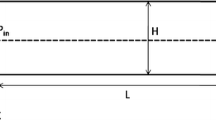Abstract
Extensive study of micro flow in rectangular channel is considered and analyzed. Numerical studies are performed by Lattice Boltzmann Method. A new combination bounce back model for the treatment of solid boundary condition is proposed. Then, three solid boundary conditions are implemented in micro rectangular channel flow. These include non-slip bounce back rule, traditional combination bounce back rule and the proposed combination bounce back rule. It is observed that the width-to-height ratio (W/H) is the major influencing parameter for rectangular micro-channel flow in low Reynolds number. And, it is also found that the drag coefficient of traditional combination bounce back rule is maximum followed by those of the proposed combination bounce back rule and non-slip bounce back rule. In non-slip bounce back rule, particles bounce back alone the opposite direction when they collide with solid boundary node and it indicates maximum drag in the macro flow. In the traditional combination bounce back rule, some particles reflect based on mirror face with non-zero tangential solid velocity. It indicates that the tangential velocity of particles is same with its original velocity. And, this leads to the minimum drag. The proposed combination bounce back velocity is somewhere in between those of bounce back rule and first combination bounce back rule.
Similar content being viewed by others
References
Hwang, S.-F. and Ji, Y.-M., “Experimental Investigation on the Design of Nozzle/Diffuser for Micropumps,” Int. J. Precis. Eng. Manuf., Vol. 15, No. 4, pp. 717–723, 2014.
Hong, D.-P., Lim, J., and Byon, C., “Semi-Analytic Correlation for Predicting Permeability of Micro-Square-Pillar Array,” Int. J. Precis. Eng. Manuf., Vol. 15, No. 7, pp. 1383–1387, 2014.
Marla, D., Barde, V., and Joshi, S. S., “Analytical Model to Predict Temperature Distribution and Ablation Depth in Excimer Laser Micromachining,” Int. J. Precis. Eng. Manuf., Vol. 14, No. 1, pp. 29–36, 2013.
Oh, H.-J., Jeon, Y.-P., Hwang, G.-W., and Kang, C.-G., “Computational Simulation for Optimizing the Thermal Hyperfine Patterning Process and Its Experimental Verification,” Int. J. Precis. Eng. Manuf., Vol. 15, No. 7, pp. 1397–1404, 2014.
Hwang, J., “Direct Observation of Fluid Action at the Chip-Tool Interface in Machining,” Int. J. Precis. Eng. Manuf., Vol. 15, No. 10, pp. 2041–2049, 2014.
Xiao, H., Tang, K., Xu, Z.-Z., Li, D.-y., and Lyu, S.-K., “Numerical Study of Shock/Vortex Interaction in Diatomic Gas Flows,” Int. J. Precis. Eng. Manuf., Vol. 17, No. 1, pp. 27–34, 2016.
Chun, B. and Ladd, A., “Interpolated Boundary Condition for Lattice Boltzmann Simulations of Flows in Narrow Gaps,” Physical Review E, Vol. 75, No. 6, Paper No. 066705, 2007.
Jiang, F. and Hu, C., “Application of Lattice Boltzmann Method for Simulation of Turbulent Diffusion from a CO2 Lake in Deep Ocean,” Journal of Novel Carbon Resource Sciences, Vol. 5, pp. 10–18, 2012.
He, B., Chen, Y., Feng, W., Li, Q., Song, A., et al., “Compressible Lattice Boltzmann Method and Applications,” International Journal of Numerical Analysis and Modeling, Vol. 9, No. 2, pp. 410–418, 2012.
Chen, S. and Doolen, G. D., “Lattice Boltzmann Method for Fluid Flows,” Annual Review of Fluid Mechanics, Vol. 30, No. 1, pp. 329–364, 1998.
Pan, C., Luo, L.-S., and Miller, C. T., “An Evaluation of Lattice Boltzmann Schemes for Porous Medium Flow Simulation,” Computers & Fluids, Vol. 35, No. 8, pp. 898–909, 2006.
Moqtaderi, H. and Esfahanian, V., “Evaluation of a New Solid Boundary Implementation in the Lattice Boltzmann Method for Porous Media Considering Permeability and Apparent Slip,” Philosophical Transactions of the Royal Society of London A: Mathematical, Physical and Engineering Sciences, Vol. 369, No. 1944, pp. 2193–2201, 2011.
Tang, G. H., Tao, W. Q., and He, Y. L., “Lattice Boltzmann Method for Gaseous Microflows using Kinetic Theory Boundary Conditions,” Physics of Fluids, Vol. 17, No. 5, Paper No. 058101, 2005.
Tang, G. H., Tao, W. Q., and He, Y. L., “Lattice Boltzmann Method for Simulating Gas Flow in Microchannels,” International Journal of Modern Physics C, Vol. 15, No. 2, pp. 335–347, 2004.
Mei, R., Shyy, W., Yu, D., and Luo, L.-S., “Lattice Boltzmann Method for 3-D Flows with Curved Boundary,” Journal of Computational Physics, Vol. 161, No. 2, pp. 680–699, 2000.
Chen, S., Tölke, J., Geller, S., and Krafczyk, M., “Lattice Boltzmann Model for Incompressible Axisymmetric Flows,” Physical Review E, Vol. 78, No. 4, Paper No. 046703, 2008.
Zhang, Y., Qin, R., and Emerson, D. R., “Lattice Boltzmann Simulation of Rarefied Gas Flows in Microchannels,” Physical Review E, Vol. 71, No. 4, Paper No. 047702, 2005.
Verhaeghe, F., Luo, L.-S., and Blanpain, B., “Lattice Boltzmann Modeling of Microchannel Flow in Slip Flow Regime,” Journal of Computational Physics, Vol. 228, No. 1, pp. 147–157, 2009.
Lim, C. Y., Shu, C., Niu, X. D., and Chew, Y. T., “Application of Lattice Boltzmann Method to Simulate Microchannel Flows,” Physics of Fluids, Vol. 14, No. 7, pp. 2299–2308, 2002.
Zhang, Y. H., Qin, R. S., Sun, Y. H., Barber, R. W., and Emerson, D. R., “Gas Flow in Microchannels-A Lattice Boltzmann Method Approach,” Journal of Statistical Physics, Vol. 121, No. 1, pp. 257–267, 2005.
Junk, M., Klar, A., and Luo, L.-S., “Asymptotic Analysis of the Lattice Boltzmann Equation,” Journal of Computational Physics, Vol. 210, No. 2, pp. 676–704, 2005.
Guo, Z., Zhao, T. S., and Shi, Y., “Physical Symmetry, Spatial Accuracy, and Relaxation Time of the Lattice Boltzmann Equation for Microgas Flows,” Journal of Applied Physics, Vol. 99, No. 7, Paper No. 074903, 2006.
Parida, P. R., “Experimental Investigation of Heat Transfer Rate in Micro-Channels,” M.Sc. Thesis, Department of Mechanical Engineering, Indian Institute of Technology Guwahati, 2007.
Author information
Authors and Affiliations
Corresponding author
Rights and permissions
About this article
Cite this article
Liu, Z., Xiao, H., Xu, ZZ. et al. The combination bounce back model for Lattice Boltzmann Method and its application on gas flow in micro machinery. Int. J. Precis. Eng. Manuf. 18, 203–209 (2017). https://doi.org/10.1007/s12541-017-0026-3
Received:
Revised:
Accepted:
Published:
Issue Date:
DOI: https://doi.org/10.1007/s12541-017-0026-3




